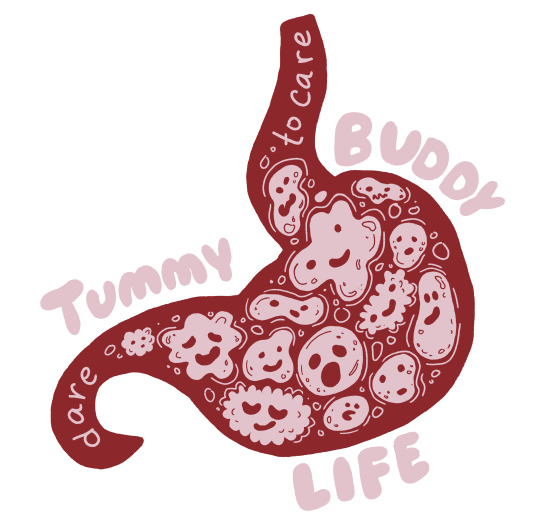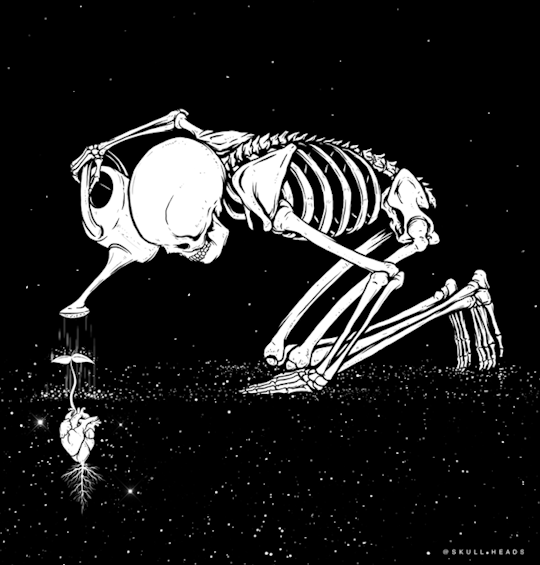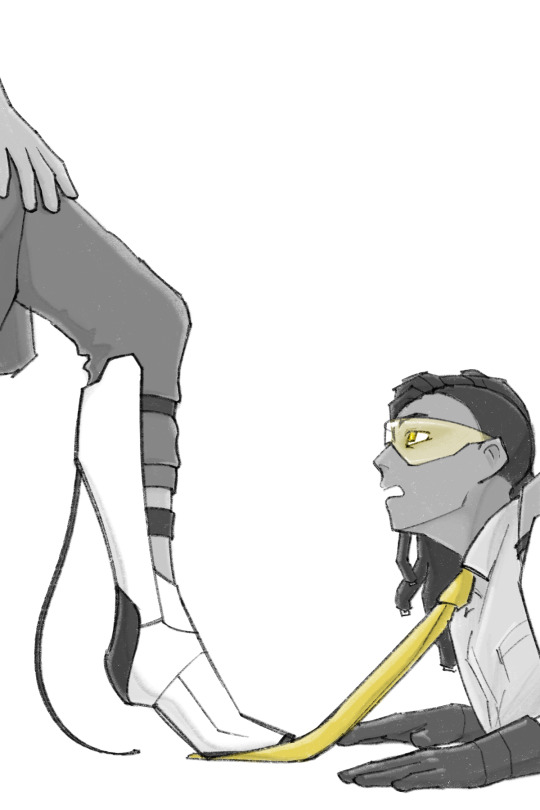#microbiom
Explore tagged Tumblr posts
Text
Playing through the greenery and litter of a mini forest's undergrowth for just one month may be enough to change a child's immune system, according to an experiment in Finland. When daycare workers rolled out a lawn, planted forest undergrowth (such as dwarf heather and blueberries), and allowed children to care for crops in planter boxes, the diversity of microbes in the guts and on the skin of the young kids appeared healthier in a very short space of time. Compared to other city kids who play in standard urban daycares with yards of pavement, tile, and gravel, 3-, 4-, and 5-year-olds at these greened-up daycare centers in Finland showed increased T-cells and other important immune markers in their blood within 28 days.
Continue Reading.
7K notes
·
View notes
Text

my illustration for the naming of the year!
#i downloaded inkscape for this and fucked around then ended up doing it all in krita because it was easier and looked better#sierra speaks#mbmbam#my brother my brother and me#tummy buddy life#microbiome#gut microbiota#mcelroys#mcelroy#i will send this into the mcelroy merch pitch. soon#digital#art
572 notes
·
View notes
Text

August 25, 2008 by mocha
#art#green#white#character#swim#mocha#i remember they used to sell these little glass microbiomes at the brookstone at the mall#they would last a few years but you couldn't open them or anything#so it was a totally closed environment barreling toward heat death#they were pretty but also sad
601 notes
·
View notes
Text
(sees a post about goldfish keeping) I miss having fish (sees a fish post) I miss having fish (sees a fosh post) i mi
#My therapist is even encouraging me to start doing fish keeping but like. I do not have the money nor the space atm. Like#i think itd do WONDERS for my mental health to have a tank with fish and a microbiome filled with live freshwater plants
270 notes
·
View notes
Text
In light of the conservative philosophy that "cuts = efficiency", consider:
A skeleton is not a more "efficient" body.
All other parts are needed for it to function.
Even "foreign bodies" live in symbiosis to form the flora on our skin and in our guts. Protecting us from infection and helping us better digest food. They are part of the body.
Even just bone and muscle is not enough when the means to sustain our energy needs are stripped out.
Reduction is not efficiency.

#tories#conservatives#uk politics#solarpunk#microbiome#eco goth#austerity#neoliberalism#neoliberal capitalism#fuck neoliberals
301 notes
·
View notes
Text
what would happen if we just. dressed as bees at the mbmbam liveshows. Twenty Honey Hive: Travis was right
#i can get down with tummy buddy life. but only in my own mind palace where it is about your microbiome#sierra speaks#mbmbam#mcelroys#twenty honey hive#20 honey hive#mbmbam naming of the year#mbmbam 2025#tummy buddy life#guys the weirdos we are gonna get in our posts now bc of the tag#im scared
201 notes
·
View notes
Text
I'm fascinated by microbiomes, the communities of bacteria, unicellular fungi, and other tiny living beings that populate various parts of animal bodies. We literally can't function without them; our gut micriobiome, for example, is crucial to our ability to digest food.
It's long been thought that the brain was kept sterile by the blood-brain barrier. However, this recent study shows that fish have a brain microbiome, so it's not entirely out of the realm of possibility we might, too. It's tough to study, because accessing the brain opens up the risk of outside contamination confounding the results of the study.
But if it is true, the implications could be huge. There's already a growing body of evidence that our gut microbiome has a significant impact on our mental health and mood through what's known as the Gut-Brain Axis. This is a series of connections between these parts of the body that includes the nervous, endocrine, immune, and other systems. Given there's about one microbial cell for every human cell in our bodies, it wouldn't be at all surprising that our microbial communities have a bigger influence on our lives than we think.
Because it's quite dangerous to study a living human brain, it will be difficult to determine whether we do have cranial microbiomes. But I'll be keeping my eye out for any further news along these lines.
#microbiome#microbes#microbiology#health#mental health#gut health#mental illness#brains#science#scicomm#nature#animals#wildlife#holobiont
161 notes
·
View notes
Text
Microbiology is such a beautiful field. I haven't always seen it that way. Microbes can be gross and working with them can be difficult. Being invisible to the naked eye, the beauty of microbes and their complex functions in the world are easy to overlook.
But y'all, microbes are the connective tissue of life on earth. They are everywhere. I work with anaerobes, which at first might seem more obscure than aerobic microbes considering the prevalence of oxygen on our planet. The reality is there is an anaerobic world within our aerobic one--the soil, our bodies, inside plants and animals, in the ocean. Many microbes that live in anaerobic soils are also found in the human gut. Microbes can make our crops more nutritious, our soils more fertile, our bodies more regulated.
Our gut microbiome is essential to our health. It isn't just this inert mass inside of us, rather it modulates immune responses, mood, digestion, inflammation, and more. We pass our microbiomes onto our babies. It's an incredibly intimate and dynamic relationship, with macroorganisms and microbiomes affecting each other in turn.
There's so much else I could say, but I'll cut myself off here. But please--even though biofilms are slimy and weird, even though nobody is thrilled when groceries go bad--give a little love to the organisms that can do virtually any metabolic process in virtually any environment and make up the foundation for all other life on our planet.
#solarpunk#sustainability#microbiology#microbes#microbiome#science#stem#scientists on tumblr#studyblr#phdblr#gradblr#sunrise says
180 notes
·
View notes
Text

close enough welcome back sophios draws portal yuri

#my next art post will be about the gut microbiome but it may contain yuri and or yaoi#portal#portal 2#chelldos#android glados#recsci au#soph's art
90 notes
·
View notes
Text
Considering that there's evidence indicating that early infancy adoption can change the composition of the gut microbiome, what do we think the impact is on Clark's?
Due to diet, and where he grew up, if he could maintain them, he's probably harbouring a pretty standard human microbiome.
Or alternatively, he's carrying around microbes that no human possibly can, because weird ones can make their home where previously there were foreign (to Earth) forms of single-celled organisms. Thus he poses a slight risk to human lovers as he can drastically alter their microbiome. Also curious if there would be health impacts due to him lacking (if Kryptonians even have a microbiome) necessary xenobacteria that are normally present, only he doesn't notice because he gets juiced by the sun.
157 notes
·
View notes
Text
The gut bacteria of giraffes are not primarily determined by what they eat, but by the species they belong to. This is shown in a new study from Uppsala University and Brown University in which researchers have analyzed the link between diet and gut flora in three giraffe species in Kenya. The study also provides new knowledge that can help secure the food supply of endangered giraffe species. In a new study published in Global Ecology and Conservation, researchers have analyzed the relationship between the diet and microbiome, or gut flora, of giraffes in Kenya. By sequencing plant and bacterial DNA from fecal samples, they were able to investigate both the bacterial composition of the gut and which plants wild giraffes had eaten.
Continue Reading.
95 notes
·
View notes
Text

Fun fact: obelisks, a new life form discovered in 2024, are viroid-like elements made of entirely novel RNA sequences. They are a distinct phylogenetic group, however scientists have yet to find a shared ancestry with another life form. Obelisks appeared in about 10% of the human microbiome examined by the Stanford University team, but their genetic sequences are very small, which might be the reason why we didn't notice them before.
#biology#virus#virology#microbiome#microbiology#science#research#scientists#science facts#science memes#scientific discovery#scientific research#obelisk#asterix and obelix#meme lord#memes#tumblr memes
95 notes
·
View notes
Text
humans are not the default race
In every scifi and fantasy setting with """races""", humans are the default.
If you're lucky, we're the short-lived, fast-reproducing pests that are all white Europeans for some mysterious reason, and also have disproportionate rates of being raised as undead because we can't be bothered to make zombie dwarf minis or animate a vampire gnome that has to jump up to bite a tall person's neck.
(We've got BOTH human AND elf skeleton warriors! Oh, hey, I just changed the scale, now it's a hobbit skeleton OR a giant skeleton! Such skeleton diversity! No, Khajiits can't be bone boys, a skeleton with a tail and a cat skull is just TOO SPOOKY)
I feel like a lot of people don't realize that we (Homo sapiens) have the longest running endurance of any land animal. Being able to run a marathon is not normal.
(It's because we evolved the very unusual hunting strategy of Slowly Chasing Gazelles While Throwing Sticks At Them Until The Gazelle Collapses From Exhaustion Then Casually Walking Up And Bashing Their Head In With A Rock™).
Even Neanderthals probably couldn't match our tenacity (they were considerably stronger and tougher though, but by no means dumber judging from the size of their brain cavities{which was bigger than ours actually})
(the evolutionary Neanderthal hunting strategy was probably something like Jumping Out And Stabbing A Wooly Rhinoceros With A Pointed Stick, Then Getting Punted 12 Feet Into a Tree But Getting Right Back Up And Doing It Again Until It Dies Because You Have Superhuman Bone And Muscle Density. And If You Do Break One Of Your Unbreakable Bones Your Homies Will Take Care Of You Until It Heals™
[Neanderthal skeletons are found with healed fractures surprisingly often despite said bones being much stronger and denser than ours, they just kept evolving denser bones until they couldn't even swim without sinking like a rock, but they still got broken all the time])
So given that we, Homo sapiens, actually literally used to be the "species that specializes in sheer endurance, determination, and unbreakable fucking will", I want more fantasy and scifi settings where we are that way! I think the only setting where that's even remotely the case is Undertale. We're not just the "default" intelligent species!
The only reason we're good at everything is because we can make complex tools and can learn and aren't bound by instinct. Which, by definition, all fantasy races would also be able to do. Otherwise, they'd just be considered animals. Like trolls or Redditers.
The "default" species should just be really good at making tools and quickly adapting, but kinda suck in every other category. So I guess gnomes or goblins are the default d&d race.
And Humans are certainly not the Tolkien "that one race that lives short lives and reproduces faster than everyone else and is good at farming" because:
A) we actually do already live relatively long lives for mammals of our size and also GIVING BIRTH CAN KILL US, AND IF OUR PARENTS DON'T RAISE US JUST RIGHT THAT CAN ALSO KILL US, WE ARE SPECIFICALLY VERY BAD AT REPRODUCING
B) we are in no way adapted to farming, and most of our modern health and societal issues stem from the fact that we aren't meant to farm or be civilized, but do it anyways.
We only farm because it helped us survive the ecological collapse at the end of the ice age, now we're in too deep to go back.
When the ice age ended (quite abruptly) the ecosystem couldn't provide for hunters and gathers anymore, a bunch of things were getting heat stroke, sea levels rose, hibernation and bloom cycles and reptile gender ratios were out of wack, predators died out because herbivores died out because plants weren't doing well. Decomposers like vultures and worms had a field day (Until they didn't [RIP condor population]). It would take a while for a new ecological equilibrium to emerge and for evolution to fix things.
But farming doesn't need any healthy ecosystems except for the soil and pollinators, mostly, so that still works. And farming makes more food meaning you can have more people. So now there's more people.
But that also means you can't ever go back to foraging without all those extra people dying of starvation. So, anarcho-primitivism would technically be the most deadly ideology if implemented, and therefore is not based, unfortunately. Here's hoping for an apocalypse to do that for us! (I would not survive it)
Fun Fact: those isolated tribal societies like the Sentinelese that still do hunting and gathering only spend 15-20 hours a week doing that and another 20 doing camp chores, and the rest of their time forming meaningful relationships and not being depressed.
Notice how most of what they do as "work" (hunting, fighting, hiking, berry/mushroom/etc picking, cooking, camping, arts and crafts, oral history/story telling) are things that we need to do during our limited free time as "hobbies" just so that our "work" doesn't drive us insane. Thus leaving less time for relationships, etc.
If we were actually good at farming or industry or civilization, then things like math and repetitive manual labor wouldn't be work. They'd be the most fun activities.
Sure, these foragers die young, but so did medieval peasant farmers who were even less healthy since they had much less diverse diets (a lot of carbs) and got plague more often thanks to cities and their close proximity to livestock. Our modern sedentary lifestyle is bad too.
Hobbits are suited to farming (also Entwives I guess). Hobbits are quite good at it, at the cost of not being as good at much else (besides going unnoticed and throwing for some reason), they inherently enjoy farming life quite a bit and most* aren't haunted by the sense they should be anything else, like we are. *(The Took family got that Call To Adventure 'tism)
We only think that we're not special or can't be anything other than what we currently are because we no longer have anything else to compare ourselves to. The Neanderthals and Denisovans died out tens of thousands of years ago and the fucking aliens are somewhere, presumably
We are special, only we survived.
But at the cost of becoming the species equivalent of an abandoned child raised by wolves. We fantasize about these things because we all know that we shouldn't be alone. But our perceptions of ourselves are twisted by our trauma and lack of socialization.
Personally, the realization that having lost our family was probably our fault makes that hurt so much worse.
#writing#writeblr#humans are space orcs#world building#science#not space orcs#A lot of space orc content goes too far with the human are special snowflakes thing#most aliens can probably *eat* or *have microbiomes*#we're just the Jogging With Murderous Intent guys who also Have A Weird Body Plan
465 notes
·
View notes
Text

#gut health#probiotics#prebiotics#fibre#fermented foods#protein boost#protein#vegan protein#protein powder#beans#health#vitamin d#gut#heal your gut#bloated gut#guthealth#bloated stomach#microbiome#micronutrients#micros#macros#healing#healthy#heal#health and fitness#health information#healthy living#healthy food#health and wellness#mental health
68 notes
·
View notes
Text
17 Apr 2025------
The tree growth acceleration technology - potentially boosting forest growth by 30 percent - has been developed by Funga PBC, and works by returning native fungal communities to tree roots before planting. These essential fungi were naturally present in forest soils but have vanished due to modern land management practices.
Scientists know that trees and fungi form a vital partnership in healthy forests because fungi create vast underground networks of microscopic threads called mycelium around tree roots. These fungal networks help trees absorb water and crucial nutrients like phosphorus and nitrogen from the soil.
In return, trees share up to 30 percent of the sugars they make through photosynthesis with their fungal partners. This exchange has evolved over millions of years, creating what scientists call a “mycorrhizal network”. These networks connect trees of different species, allowing them to share resources. Older, larger trees often support younger saplings through these fungal connections.
The accelerated tree growth has significant implications for fighting climate change. According to Funga’s field trials, forests with restored fungal communities can capture up to 40 percent more carbon dioxide annually compared to conventional plantings.
“Funga’s method could create planet-shaping impact,” says Dan Lambe, chief executive of the Arbor Day Foundation.
#good news#environmentalism#science#environment#reforestation#fungi#microbiology#microbiomes#tree growth acceleration#climate crisis#climate change#nature#forests#rainforests#mushrooms#mycology#fungus#conservation#climate action#climate hope#global climate change#climate activism#climate#climate and environment#climate emergency#climate justice#climate science#climate solutions#mycelium
52 notes
·
View notes
